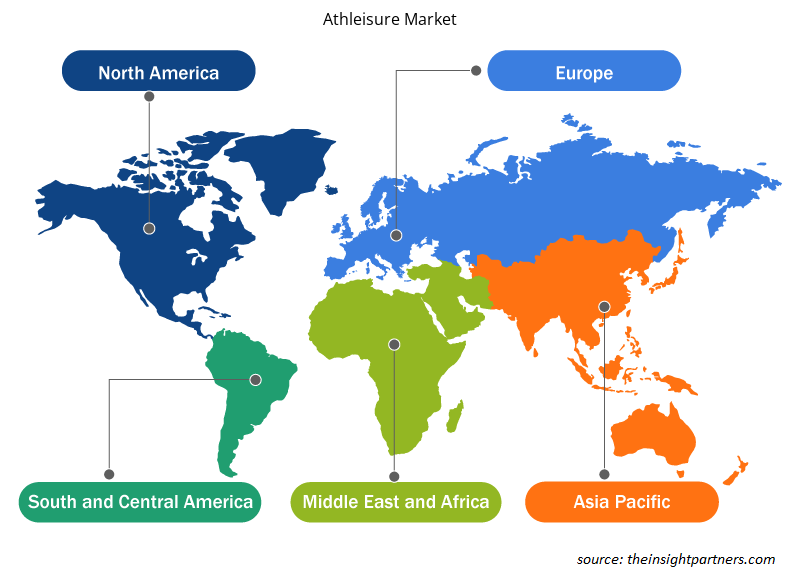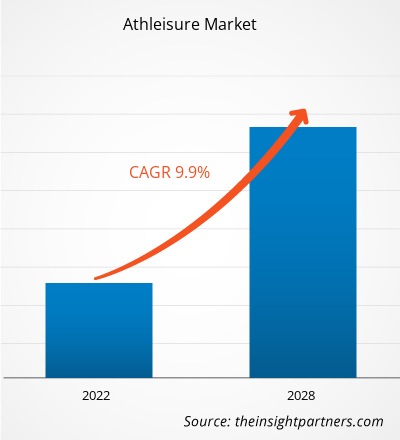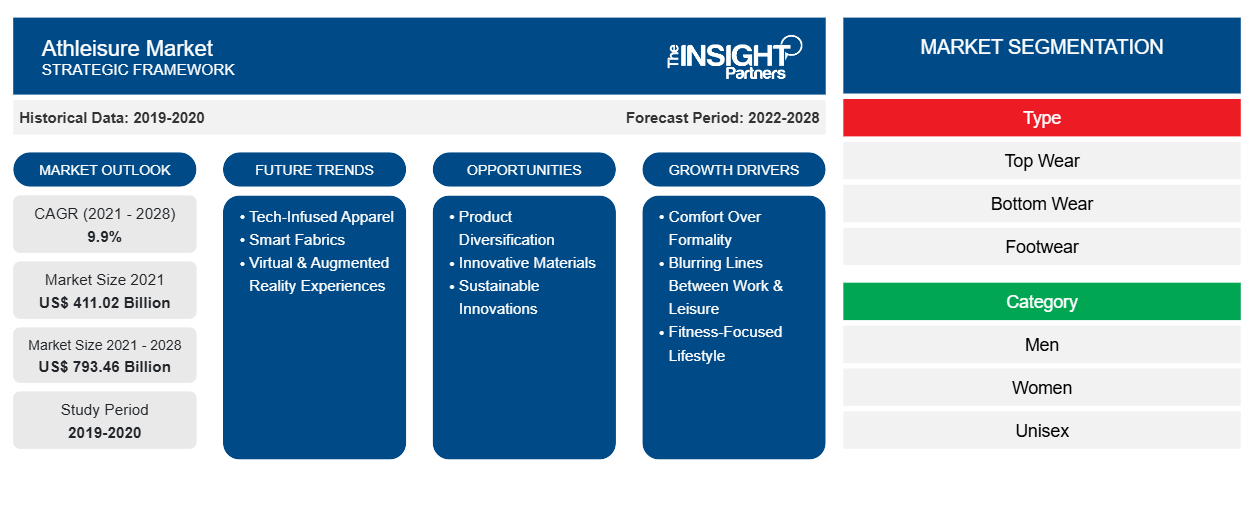Se espera que el mercado de ropa deportiva crezca de 411.020 millones de dólares en 2021 a 793.460 millones de dólares en 2028; se estima que crecerá a una CAGR del 9,9% entre 2021 y 2028.
El término "athleisure" hace referencia a la tendencia de moda que se caracteriza por prendas deportivas cómodas y estéticamente atractivas. Están confeccionadas con materiales que son tradicionalmente específicos de la ropa deportiva y de gimnasio, pero que están diseñadas para ser apropiadas para la ropa informal de uso diario.
En 2020, América del Norte dominó el mercado global y se espera que mantenga su dominio durante el período de pronóstico. El aumento de la conciencia sobre la adopción de estilos de vida saludables ha animado a los clientes de América del Norte a participar en actividades de fitness/deporte, lo que está impulsando la demanda de athleisure en la región. Además, la creciente presencia de marcas internacionales y nacionales, y el aumento de los ingresos disponibles de las personas, junto con el deseo de adoptar mejores estilos de vida, están impulsando la demanda de athleisure en la región. La aceptación de la vestimenta deportiva en diversos entornos sociales ha aumentado notablemente en los últimos años. Las búsquedas de moda de ropa de yoga crecieron en 2020 en los EE. UU. y los clientes están optando por más colores en sus productos de yoga. Además, Asia Pacífico ocupó la segunda participación más grande del mercado global, lo que puede atribuirse a la creciente popularidad de los equipos deportivos de moda, incluida la ropa y el calzado deportivos, entre los millennials de la región.
Personalice este informe según sus necesidades
Obtendrá personalización en cualquier informe, sin cargo, incluidas partes de este informe o análisis a nivel de país, paquete de datos de Excel, así como también grandes ofertas y descuentos para empresas emergentes y universidades.
- Obtenga las principales tendencias clave del mercado de este informe.Esta muestra GRATUITA incluirá análisis de datos, desde tendencias del mercado hasta estimaciones y pronósticos.
Perspectivas del mercado
El aumento de la conciencia de los consumidores sobre la salud y la actividad física impulsa el crecimiento del mercado
En los últimos años, ha aumentado la conciencia sobre la salud y la forma física entre los consumidores de todo el mundo. Según una encuesta de McKinsey and Company, en la que participaron seis países (Brasil, China, Alemania, Reino Unido, EE. UU. y Japón), el 79 % de los encuestados afirmó que el bienestar es importante y el 42 % consideró que el bienestar es una prioridad máxima. Esto indica que los consumidores de diferentes países están priorizando su salud y su forma física, lo que ha llevado a una mayor participación en yoga, gimnasios y actividades deportivas. La demanda de ropa y calzado adecuados y de moda entre estos consumidores preocupados por la salud está aumentando, lo que impulsa el crecimiento del mercado.
Tipo de información
Según el tipo, el mercado se segmenta en ropa de abrigo, ropa de abrigo, calzado y otros. Se espera que el segmento de calzado sea el de más rápido crecimiento en el mercado de ropa deportiva . El calzado se ha convertido en una parte integral de las actividades deportivas y de fitness de las personas. Los consumidores demandan cada vez más calzado con diferentes estilos y diseños que se pueda utilizar en gimnasios y actividades de fitness, así como en eventos al aire libre.
Entre los actores clave que operan en el mercado se encuentran Adidas AG, Asics, Athleta LLC, Authentic Brands Group, Columbia Sportswear Company, Hennes and Mauritz AB, Lululemon Athletica, Nike, Inc., Puma SE y Under Armour Inc. Los principales actores adoptan diversas estrategias, como fusiones y adquisiciones, y lanzamientos de productos para expandir su presencia geográfica y su base de consumidores.
Perspectivas regionales del mercado del ocio deportivo
Los analistas de Insight Partners explicaron en detalle las tendencias y los factores regionales que influyen en el mercado de ropa deportiva durante el período de pronóstico. Esta sección también analiza los segmentos y la geografía del mercado de ropa deportiva en América del Norte, Europa, Asia Pacífico, Oriente Medio y África, y América del Sur y Central.

- Obtenga los datos regionales específicos para el mercado de ropa deportiva
Alcance del informe sobre el mercado de ropa deportiva
| Atributo del informe | Detalles |
|---|---|
| Tamaño del mercado en 2021 | US$ 411.02 mil millones |
| Tamaño del mercado en 2028 | US$ 793,46 mil millones |
| CAGR global (2021-2028) | 9,9% |
| Datos históricos | 2019-2020 |
| Período de pronóstico | 2022-2028 |
| Segmentos cubiertos | Por tipo
|
| Regiones y países cubiertos | América del norte
|
| Líderes del mercado y perfiles de empresas clave |
|
Densidad de actores del mercado de ropa deportiva: comprensión de su impacto en la dinámica empresarial
El mercado de ropa deportiva está creciendo rápidamente, impulsado por la creciente demanda de los usuarios finales debido a factores como la evolución de las preferencias de los consumidores, los avances tecnológicos y una mayor conciencia de los beneficios del producto. A medida que aumenta la demanda, las empresas amplían sus ofertas, innovan para satisfacer las necesidades de los consumidores y aprovechan las tendencias emergentes, lo que impulsa aún más el crecimiento del mercado.
La densidad de actores del mercado se refiere a la distribución de las empresas o firmas que operan dentro de un mercado o industria en particular. Indica cuántos competidores (actores del mercado) están presentes en un espacio de mercado determinado en relación con su tamaño o valor total de mercado.
Las principales empresas que operan en el mercado Athleisure son:
- adidas AG
- Compañía de ropa deportiva de Columbia
- Brecha Inc.
- Hennes & Mauritz AB
- Corporación ASICS
Descargo de responsabilidad : Las empresas enumeradas anteriormente no están clasificadas en ningún orden particular.

- Obtenga una descripción general de los principales actores clave del mercado Athleisure
Informe Destacado
- Tendencias progresivas en la industria del athleisure para ayudar a los jugadores a desarrollar estrategias efectivas a largo plazo
- Estrategias de crecimiento empresarial adoptadas por las empresas para asegurar el crecimiento en los mercados desarrollados y en desarrollo
- Análisis cuantitativo del mercado del athleisure de 2019 a 2028
- Análisis PEST para ilustrar la eficacia de los compradores y proveedores que operan en la industria del athleisure
- Desarrollos recientes para comprender el escenario competitivo del mercado y la demanda de ropa deportiva
- Tendencias y perspectivas del mercado junto con los factores que rigen el crecimiento del mercado de ropa deportiva
- Comprensión de las estrategias que sustentan el interés comercial sobre el crecimiento del mercado de ropa deportiva, ayudando en el proceso de toma de decisiones.
- Tamaño del mercado de ropa deportiva en varios nodos del mercado
- Descripción detallada y segmentación del mercado de ropa deportiva y de ocio, así como de su dinámica industrial
- Tamaño del mercado de ropa deportiva en varias regiones con oportunidades de crecimiento prometedoras
El "Análisis del mercado global de ropa deportiva hasta 2028" es un estudio especializado y profundo de la industria de bienes de consumo, que se centra en el análisis de las tendencias del mercado de ropa deportiva. El informe tiene como objetivo proporcionar una descripción general del mercado con una segmentación detallada del mercado. El mercado de ropa deportiva está segmentado en función del tipo, la categoría, el canal de distribución y la geografía. Según el tipo, el mercado se segmenta en ropa superior, ropa inferior, calzado y otros. Según la categoría, el mercado de ropa deportiva está segmentado en hombres, mujeres, unisex y niños. Según el canal de distribución, el mercado está segmentado en supermercados e hipermercados, tiendas especializadas, venta minorista en línea y otros. Según la geografía, el mercado está segmentado en cinco regiones principales: América del Norte, Europa, Asia Pacífico (APAC), América del Sur y Central (SCAM) y Oriente Medio y África (MEA). Se espera que Asia-Pacífico sea el segmento de más rápido crecimiento en el mercado de ropa deportiva, seguido de América del Norte.
Perfiles de empresas
- adidas AG
- Asics
- Atleta LLC
- Grupo de marcas autenticas
- Compañía de ropa deportiva de Columbia
- Hennes y Mauritz AB
- Lululemon Athletica
- Nike, Inc.
- Puma SE
- Debajo de la armadura inc.
- Análisis histórico (2 años), año base, pronóstico (7 años) con CAGR
- Análisis PEST y FODA
- Tamaño del mercado, valor/volumen: global, regional y nacional
- Industria y panorama competitivo
- Conjunto de datos de Excel
Informes recientes
Testimonios
Razón para comprar
- Toma de decisiones informada
- Comprensión de la dinámica del mercado
- Análisis competitivo
- Información sobre clientes
- Pronósticos del mercado
- Mitigación de riesgos
- Planificación estratégica
- Justificación de la inversión
- Identificación de mercados emergentes
- Mejora de las estrategias de marketing
- Impulso de la eficiencia operativa
- Alineación con las tendencias regulatorias





















 Obtenga una muestra gratuita para - Mercado de ropa deportiva
Obtenga una muestra gratuita para - Mercado de ropa deportiva